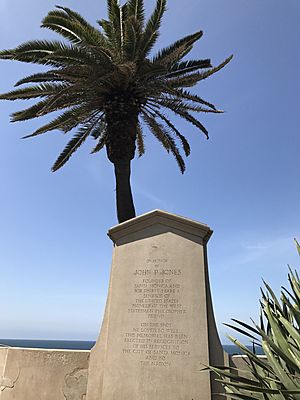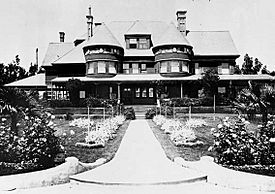John Percival Jones facts for kids
Quick facts for kids
John P. Jones
|
|
|---|---|
 |
|
| United States Senator from Nevada |
|
| In office March 4, 1873 – March 3, 1903 |
|
| Preceded by | James W. Nye |
| Succeeded by | Francis G. Newlands |
| Personal details | |
| Born | January 27, 1829 Herefordshire, England |
| Died | November 27, 1912 (aged 83) Los Angeles, California |
| Political party | Republican, Silver (1895-1901) |
| Profession | Mining |
| Signature | |
John Percival Jones (born January 27, 1829 – died November 27, 1912) was an American politician. He was a Senator for Nevada for 30 years, representing the Republican Party. John P. Jones became very wealthy from silver mining. He also helped start the famous city of Santa Monica, California.
Contents
Early Life and Moving to America
John P. Jones was born in Herefordshire, England, on January 27, 1829. He was one of thirteen children. When he was just two years old, in 1831, his family moved to the United States. They settled in Cleveland, Ohio. His father, Thomas Jones, bought property and started a business making marble products.
California Gold Rush Adventures
In 1849, when he was 20 years old, John P. Jones traveled to California. He wanted to join the exciting Gold rush. He settled in Trinity County, California. There, he worked in mining and farming. He even served as the county sheriff. From 1863 to 1867, he was a member of the California state senate. This meant he helped make laws for California.
Mining Success in Nevada
In 1868, Jones moved to Gold Hill, Nevada. He became the boss of the Crown Point silver mine. This mine was part of the famous Comstock Lode, a huge silver discovery. In 1870, a large amount of silver ore was found in the mine. Jones and his partner, Alvinza Hayward, bought more shares. This gave them control of the Crown Point mine.
Serving in the United States Senate
In 1873, John P. Jones was chosen by the Nevada Legislature to be a U.S. Senator. He served for five terms, from 1873 to 1903, which is 30 years! As a Senator, he worked on important committees. He was involved with creating the Twenty-cent silver coin.
Around 1896, Jones left the Republican Party. This was because of a debate about "bimetallism." This idea was about using both gold and silver to back money. He joined the Silver Party, which supported using silver. Later, he rejoined the Republican Party. He decided not to run for re-election in 1902.
Panamint Silver Mines Investment
In 1874, Jones and another Nevada senator, William M. Stewart, invested in the Panamint silver mines. These mines were located near Independence, in Inyo County, California. Jones had a big plan to build a railroad from these mines all the way to the ocean at Santa Monica. However, by 1877, the Panamint mines ran out of silver and closed down.
Founding Santa Monica

In 1874, Jones visited Los Angeles. He bought a large part of a ranch in Santa Monica. The ranch belonged to Colonel Robert S. Baker. In 1875, Jones and Baker worked together to plan and create the town of Santa Monica.
Jones also built the first railroad from Los Angeles to Santa Monica. It was called the Los Angeles and Independence Railroad. But due to money problems, Jones had to sell the railroad in 1877. It was sold to the Southern Pacific.
Miramar: John Jones' Home

In 1903, after leaving the Senate, Jones retired to his home in Santa Monica. This home, built in 1889, was called Miramar. He continued to manage his businesses from there.
Just before Senator Jones passed away, Miramar was sold to King Gillette, who invented Gillette razors. Gillette didn't visit the house much. After a short time as a military school for boys during World War I, the estate was sold again. In 1921, it became the Hotel Miramar.
The original mansion was taken down in 1938. The oldest part of the hotel now is the "Palisades" wing, built in 1924. A famous Moreton Bay Fig Tree, given to the Jones family in 1889, still stands there today. The site is now home to the Fairmont Miramar Hotel.
Family and Later Life
John P. Jones married Hannah Cornelia (Conger) Greathouse in 1861. They had one son named Roy. Hannah passed away in 1871. In 1875, Jones married Georgina Frances Sullivan. They had three daughters: Alice, Marion, and Georgina.
John P. Jones died in 1912 in Los Angeles, California. He was buried in Laurel Hill Cemetery in San Francisco, California.

